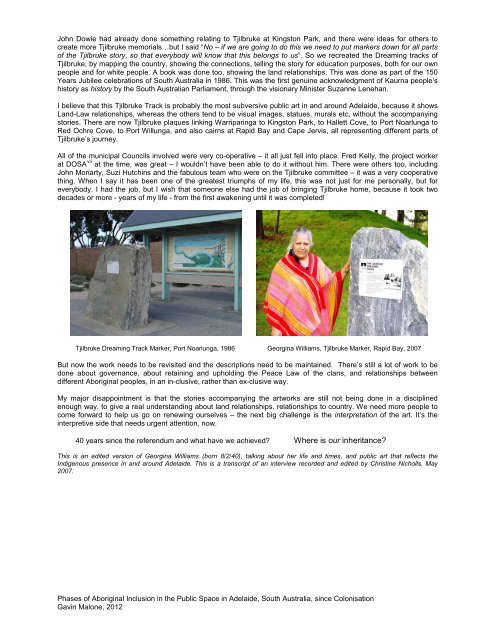Appendix A Ways of Belonging - Theses - Flinders University
Appendix A Ways of Belonging - Theses - Flinders University
Appendix A Ways of Belonging - Theses - Flinders University
You also want an ePaper? Increase the reach of your titles
YUMPU automatically turns print PDFs into web optimized ePapers that Google loves.
John Dowie had already done something relating to Tjilbruke at Kingston Park, and there were ideas for others tocreate more Tjilbruke memorials…but I said “No – if we are going to do this we need to put markers down for all parts<strong>of</strong> the Tjilbruke story, so that everybody will know that this belongs to us”. So we recreated the Dreaming tracks <strong>of</strong>Tjilbruke, by mapping the country, showing the connections, telling the story for education purposes, both for our ownpeople and for white people. A book was done too, showing the land relationships. This was done as part <strong>of</strong> the 150Years Jubilee celebrations <strong>of</strong> South Australia in 1986. This was the first genuine acknowledgment <strong>of</strong> Kaurna people’shistory as history by the South Australian Parliament, through the visionary Minister Suzanne Lenehan.I believe that this Tjilbruke Track is probably the most subversive public art in and around Adelaide, because it showsLand-Law relationships, whereas the others tend to be visual images, statues, murals etc, without the accompanyingstories. There are now Tjilbruke plaques linking Warriparinga to Kingston Park, to Hallett Cove, to Port Noarlunga toRed Ochre Cove, to Port Willunga, and also cairns at Rapid Bay and Cape Jervis, all representing different parts <strong>of</strong>Tjilbruke’s journey.All <strong>of</strong> the municipal Councils involved were very co-operative – it all just fell into place. Fred Kelly, the project workerat DOSA vii at the time, was great – I wouldn’t have been able to do it without him. There were others too, includingJohn Moriarty, Suzi Hutchins and the fabulous team who were on the Tjilbruke committee – it was a very cooperativething. When I say it has been one <strong>of</strong> the greatest triumphs <strong>of</strong> my life, this was not just for me personally, but foreverybody. I had the job, but I wish that someone else had the job <strong>of</strong> bringing Tjilbruke home, because it took twodecades or more - years <strong>of</strong> my life - from the first awakening until it was completed!Tjilbruke Dreaming Track Marker, Port Noarlunga, 1986 Georgina Williams, Tjilbruke Marker, Rapid Bay, 2007But now the work needs to be revisited and the descriptions need to be maintained. There’s still a lot <strong>of</strong> work to bedone about governance, about retaining and upholding the Peace Law <strong>of</strong> the clans, and relationships betweendifferent Aboriginal peoples, in an in-clusive, rather than ex-clusive way.My major disappointment is that the stories accompanying the artworks are still not being done in a disciplinedenough way, to give a real understanding about land relationships, relationships to country. We need more people tocome forward to help us go on renewing ourselves – the next big challenge is the interpretation <strong>of</strong> the art. It’s theinterpretive side that needs urgent attention, now.40 years since the referendum and what have we achieved? Where is our inheritance?This is an edited version <strong>of</strong> Georgina Williams (born 8/2/40), talking about her life and times, and public art that reflects theIndigenous presence in and around Adelaide. This is a transcript <strong>of</strong> an interview recorded and edited by Christine Nicholls, May2007.Phases <strong>of</strong> Aboriginal Inclusion in the Public Space in Adelaide, South Australia, since ColonisationGavin Malone, 2012















